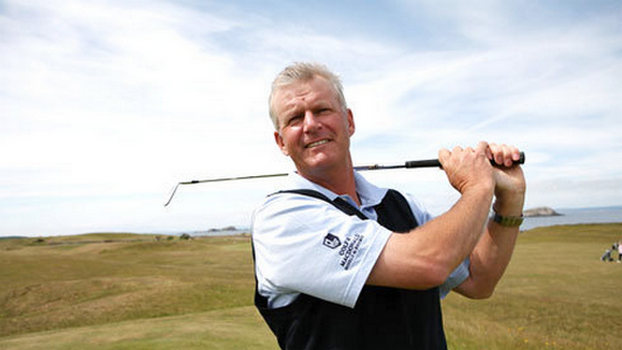The time frame in being competitive at the top of the pecking order for world class golfers varies immensely. Some can see the mountain top — but never get near. Others have moments but time is measured in a few years — at best. The rarest are those that maintain relevancy for several years or even more. Rest assured — all competitors are keenly aware the footing they have rests on sand — not concrete.

During Europe’s ascent on the global golf stage from the late 1970s and into the 1980s a cadre of golfers entered the scene showcasing not only their respective talents but changing a storyline where virtuoso golf was centered solely by American players on American soil.
Spain’s Seve Ballesteros led the effort with his dashing play and unbridled verve. Through the appointment of England’s Tony Jacklin as Captain for team Europe the competitive imbalance of Ryder Cup play would soon flip from USA dominance to European stronghold.
The arrival of Ballesteros also marked the coming onto the scene of others showcasing a range of skills and personalities.
Lyle’s win at Royal St. George’s marked the first Scotsman to claim the Claret Jug in over 70 years
The name Alexander Walter Barr Lyle, M.B.E., may not strike a chord of remembrance for many but when shortened to include just his nickname “Sandy” the memories of his exquisite play are both remembered and rightly celebrated.
Although born in England in 1958 — Sandy was the proud son of Scottish parents and golf was most certainly in his blood as his father was an active head golf professional at Hawkstone Park Golf Course in England during Lyle’s earliest years.
Sandy’s success as a teen was clearly on display. Amateur victories piled up and in 1977 he was selected as a member of the UK and Ireland side to play on the Walker Cup team. Lyle would quickly turn professional following those matches and his success professionally was quickly realized with wins on Africa’s Safari Tour.
However, it was in 1979 when Sandy elevated his play to even wider attention with three wins on the European Tour — including a triumph over Ballesteros in a head-to-head confrontation at the 1979 Scandinavian Open thereby pushing him to the top of the European Order of Merit. From that year through 1985 his performance in the Order would demonstrate profound consistency — 1st, 1st, 3rd, 2nd, 5th, 4th and 1st.

The missing ingredient for Lyle was bringing his considerable talents for the ultimate prizes and validation in world class golf — the game’s major championships. Sandy had first played in The Open Championship at age 16 in 1974. But since that start and through the ’85 Open Championship played at Royal St. George’s, his best finish had been a T8 at the ’82 event at Royal Troon.
At Sandwich, Lyle would trail by three entering the final round but a final round 70 was good enough to snare the Claret Jug by one stroke over American Payne Stewart. The victory did not come easily for Lyle — on the final hole he badly misplayed a chip shot to the final green but was able to quickly recover and secure his first major win. Lyle became the first UK champion since Tony Jacklin had won the event in 1969,and more importantly, the first Scot to do so since Jock Hutchinson won in 1921. The triumph catapulted Lyle to the highest of levels in professional golf. 1985 would also mark other high watermarks — Bernhard Langer becoming the first German to claim the green jacket at the Masters and later that same year Team Europe reclaiming the Ryder Cup for the first time since 1957.
Given his success on the European Tour, Lyle opted to cross the pond and attempt to also find success on the PGA Tour. In short order Sandy would claim six victories with the most notable coming in 1987 when he became the first foreign born player to claim the Players Championship in a rousing playoff win over Jeff Sluman.
Lyle’s ascension was clearly on the fast track for success and in 1988 he elevated his game and overall stature to even greater heights.
The Masters at Augusta National was well known to Lyle but in six previous visits never finishing once in the top ten. The Scotsman was resolute in his performance and after 54 holes held a two-stroke lead over the USA’s Mark Calcavecchia. Lyle would forever add his name to the history of the Masters when after finding a fairway bunker at the 18th hole he struck a 7-iron with the ball finishing 15 feet away. Lyle holed the birdie putt for a one stroke win over Calcavecchia becoming the first Briton to win the green jacket.
The celebratory dance Sandy displayed after dropping his winning birdie will never be confused with the likes of Michael Jackson. What many do not realize is how tenacious Lyle was during that final round — when after bogeying the 11th and double-bogeying the dangerous par-3 12th he recovered to birdie two of the final three holes for the victory.
Lyle was gifted in many ways via his golf clubs. The Scotsman had considerable strength and was known for his long-hitting. Interestingly, Lyle was not given any credit for finishing just off the green at the previously unreachable par-5 17th on Baltusrol’s Lower Course during the 1993 U.S. Open. Unfortunately, his second shot rolled just off to the right of the green while the USA’s John Daly was able to see his 1-iron second shot bounce on and remain on the green.
For many golfers when they reach their mid-30s the expectation is that more key wins would be likely to occur. For Lyle, like Ballesteros, that was not to happen. After his win at Augusta in 1988 the Scot would only record one additional top ten finish in a major championship. Sadly, his best days were now in the rear-view mirror.
The lone notable empty space for Lyle’s career was never being selected Captain of the European Ryder Cup team. He had served as an assistant to Ian Woosnam in the ’08 matches and was primed to be chosen for the ’10 event, however, the Captaincy was bestowed on fellow Scotsman Colin Montgomerie. That lone void was countered to a degree with Lyle’s rightful admittance to the World Golf Hall of Fame in 2012. Yet the sting in seeing other contemporaries — Ballesteros, Woosnam, Langer and Nick Faldo all chosen as Captains with him shutout still resonates to this day.
In assessing Lyle’s career few ever mention that during his peak years he remained in the top ten of the world golf rankings for 167 consecutive weeks along with 18 wins on the European Tour.
Now 63 years of age, Lyle’s success at Royal St. George’s during the ’85 Open Championship served as his spring board event on the global stage.
Jacklin paid Lyle the ultimate compliment — “Sandy Lyle is a forgotten hero. His achievements – and what an enormously talented golfer he was – tend to be overlooked. But when he had confidence in his putting, he was a great player. Everything looked so easy.“
Indeed, when on form — Sandy was a legitimate golf dandy.
